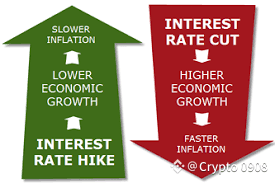Interest rates, particularly those set by central banks like the Federal Reserve, have a significant impact on financial markets, and the cryptocurrency market is no exception. While cryptocurrencies operate on decentralized networks, their values are still influenced by broader economic conditions and investor behavior.
Here's a breakdown of how interest rates impact cryptocurrency and how crypto-specific "interest" works:
Impact of Traditional Interest Rates on Cryptocurrency

The relationship between traditional interest rates and cryptocurrency prices generally follows this rule:
* Lower Interest Rates = Generally Higher Crypto Prices:
* Increased Liquidity: When central banks lower interest rates, it becomes cheaper for businesses and individuals to borrow money. This injects more liquidity into the financial system, leading investors to seek higher returns than what traditional low-interest savings accounts or bonds offer.
* Higher Risk Appetite: With lower borrowing costs and less attractive "safe" investments, investors are more inclined to take on riskier assets, including cryptocurrencies. This can lead to an "infusion of new money" into the crypto market.
* Opportunity Cost: The opportunity cost of holding non-yielding assets like Bitcoin decreases when interest rates are low. Investors might prefer to hold crypto in hopes of appreciation rather than earning minimal interest elsewhere.
* Stimulus for the Economy: Lower interest rates are often implemented to stimulate economic growth. This can create a more speculative environment where assets like crypto thrive.
* Higher Interest Rates = Generally Lower Crypto Prices:
* Reduced Liquidity: When central banks raise interest rates, borrowing becomes more expensive. This tightens monetary policy, reducing the overall money supply and making it less attractive to invest in speculative assets.
* Lower Risk Appetite: Higher interest rates make traditional assets like bonds and savings accounts more attractive, as they offer better returns with lower risk. This can draw capital away from riskier investments like cryptocurrencies.
* Increased Opportunity Cost: The opportunity cost of holding non-yielding crypto increases when "safe" investments offer better returns.
* Stronger Dollar: Higher interest rates can lead to a stronger national currency (like the US Dollar), which can make cryptocurrencies relatively more expensive for international investors.
* Market Sentiment: Rising rates can shift overall market sentiment towards caution, leading to a decline in demand and potential price drops in crypto.
Important Considerations:
* Volatility: The crypto market is known for its volatility, and interest rate changes can further amplify this, especially in the short term.
* Long vs. Short Term: While short-term volatility is common, the long-term impact of interest rates on the fundamental value proposition of a cryptocurrency (e.g., its technology, adoption, use case) may not be as significant.
* Decentralization Narrative: Some argue that Bitcoin, due to its fixed supply and decentralized nature, can act as a hedge against central bank policies and inflation, especially during periods of economic instability or currency devaluation.
How "Interest Rates" Work in Cryptocurrency (DeFi)
Within the cryptocurrency ecosystem, particularly in Decentralized Finance (DeFi), you can also encounter "interest rates" that are distinct from central bank rates. These typically involve lending and borrowing crypto assets.
Here's how they generally work:
* Lending Platforms: Users can deposit their cryptocurrencies (e.g., Bitcoin, Ethereum, stablecoins like USDT or USDC) onto DeFi lending platforms or centralized crypto exchanges (CeFi) that offer lending services.
* Lending Pools: These deposited assets typically go into a "lending pool."
* Borrowers: Other users can then borrow from these pools, usually by providing collateral (often more crypto than the value of the loan, known as overcollateralization).
* Interest Payments: Borrowers pay interest on the crypto they borrow. This interest is then distributed back to the lenders as a reward for providing liquidity.
* Annual Percentage Rate (APR) vs. Annual Percentage Yield (APY):
* APR (Annual Percentage Rate): This is the simple yearly interest rate earned or paid, without factoring in compounding.
* APY (Annual Percentage Yield): This includes the effect of compounding, meaning interest earned on previously earned interest. APY will always be higher than APR if compounding occurs.
* Factors Influencing Crypto Interest Rates:
* Demand and Supply: The most significant factor. If there's high demand for borrowing a particular cryptocurrency and low supply from lenders, the interest rate will be higher. Conversely, high supply from lenders and low borrowing demand will lead to lower rates.
* Platform Policies: Each lending platform or protocol sets its own parameters and fee structures, which influence the rates offered.
* Risk: Higher interest rates in crypto often reflect higher risk. This can be due to the volatility of the underlying asset, smart contract risks (in DeFi), or the overall risk profile of the lending platform.
* Collateralization: The loan-to-value (LTV) ratio (the amount of collateral required relative to the loan amount) also plays a role.
* Market Conditions: General crypto market sentiment and volatility can impact lending and borrowing demand.
Types of Crypto Interest-Earning Opportunities:
* Staking: Locking up cryptocurrency to support a blockchain network's operations (e.g., in Proof-of-Stake systems) in exchange for rewards, often expressed as an APR or APY.
* Lending: As described above, providing crypto to a platform for others to borrow in exchange for interest. This can be done through:
* Decentralized Lending Platforms (DeFi): Protocols like Aave or Compound where smart contracts automate the lending and borrowing process without traditional intermediaries.
* Centralized Lending Platforms (CeFi): Exchanges or dedicated lending platforms that act as intermediaries, custodying your funds and managing the loans.
* Yield Farming: A more complex DeFi strategy involving moving crypto between various protocols to maximize returns through a combination of lending, borrowing, and liquidity provision, often earning multiple types of rewards.
In summary, while traditional interest rates set by central banks influence the overall flow of capital and risk appetite in the broader financial markets (including crypto), within the crypto space itself, "interest" is generated through various mechanisms like lending, staking, and yield farming, driven by the supply and demand for digital assets on decentralized or centralized platforms.